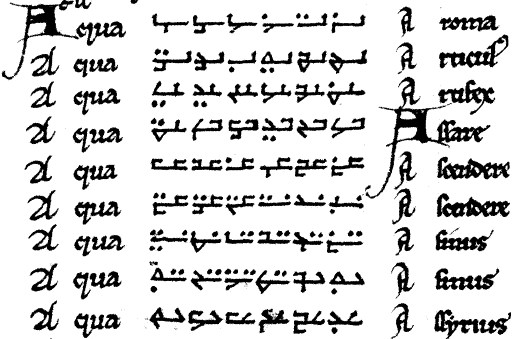The medieval Cistercian numerals, or 'ciphers' in 19th-century parlance, were developed by the Cistercian monastic order in the early 13th century at about the time that Arabic numerals were introduced to northwestern Europe. They are more compact than Arabic or Roman numerals, with a single character able to indicate any integer from 1 to 9999. Is this cipher secret or occult?
Digits are based on a horizontal or vertical stave, with the position of the digit on the stave indicating its place value (units, tens, hundreds or thousands). These digits are compounded on a single stave to indicate more complex numbers. After the Cistercians abandoned the system in favor of the Arabic numerals, marginal use continued until the early 20th century, with Freemasons, occultists and Nazis all briefly flirting with it.
The definitive account of the Cistercian numerals is The Ciphers of the Monks: A Forgotten Number-notation of the Middle Ages is a book by David A. King published in 2001.
The digits and idea of forming them into ligatures were apparently based on a two-place (1–99) numeral system introduced into the Cistercian Order by John of Basingstoke, archdeacon of Leicester, who it seems based them on a twelfth-century English shorthand (ars notaria). Basingstoke's biographer claimed that he learned his system from his teacher in Athens. However, there is no known parallel among Greek numbering systems. It seems more likely that Basingstoke picked up the idea of alphabetic numerical notation in Greece and applied it to an English ars notaria, such as the one commonly attributed to John of Tilbury at right.
In its earliest attestations, in the monasteries of the County of Hainaut, the Cistercian system was not used for numbers greater than 99, but it was soon expanded to four places, enabling numbers up to 9999.
The two dozen or so surviving Cistercian manuscripts that use the system date from the thirteenth to the fifteenth century, and cover an area from England to Italy, Normandy to Sweden. The numbers were not used for arithmetic or accounting, but for year dates, foliation (numbering pages), divisions of texts, numbering notes and other lists, indexes and concordances, arguments in Easter tables, the lines of a staff in musical notation and in one known case, the calendrical, angular and other numbers on the astrolabe of Berselius made in the XIV century in French Picardy. They were used by wine-gaugers in the Bruges area at least until the early eighteenth century.
In 1533, Heinrich Cornelius Agrippa von Nettesheim included a description of these ciphers in his Three Books of Occult Philosophy. History shows, however, that the Cistercian Cipher was simply a practical shorthand for large numbers, was not secret and had no occult bearing.
A horizontal stave was most common, while the numerals were in use among the Cistercians. A vertical stave was attested only in Northern France, in the fourteenth and fifteenth centuries. However, 19th- and 20th-century revivals of the system in France and Germany used a vertical stave.
Today there is an online tool to convert, read or write the Cistercian numbers in the vertical stave form, changing them into or from Arabic numerals. It can be found here
Source text and illustration Wikipedia
Support TemplarsNow™ by becoming a Patron, tipping us or buying one of our Reliable Books

No comments:
Post a Comment